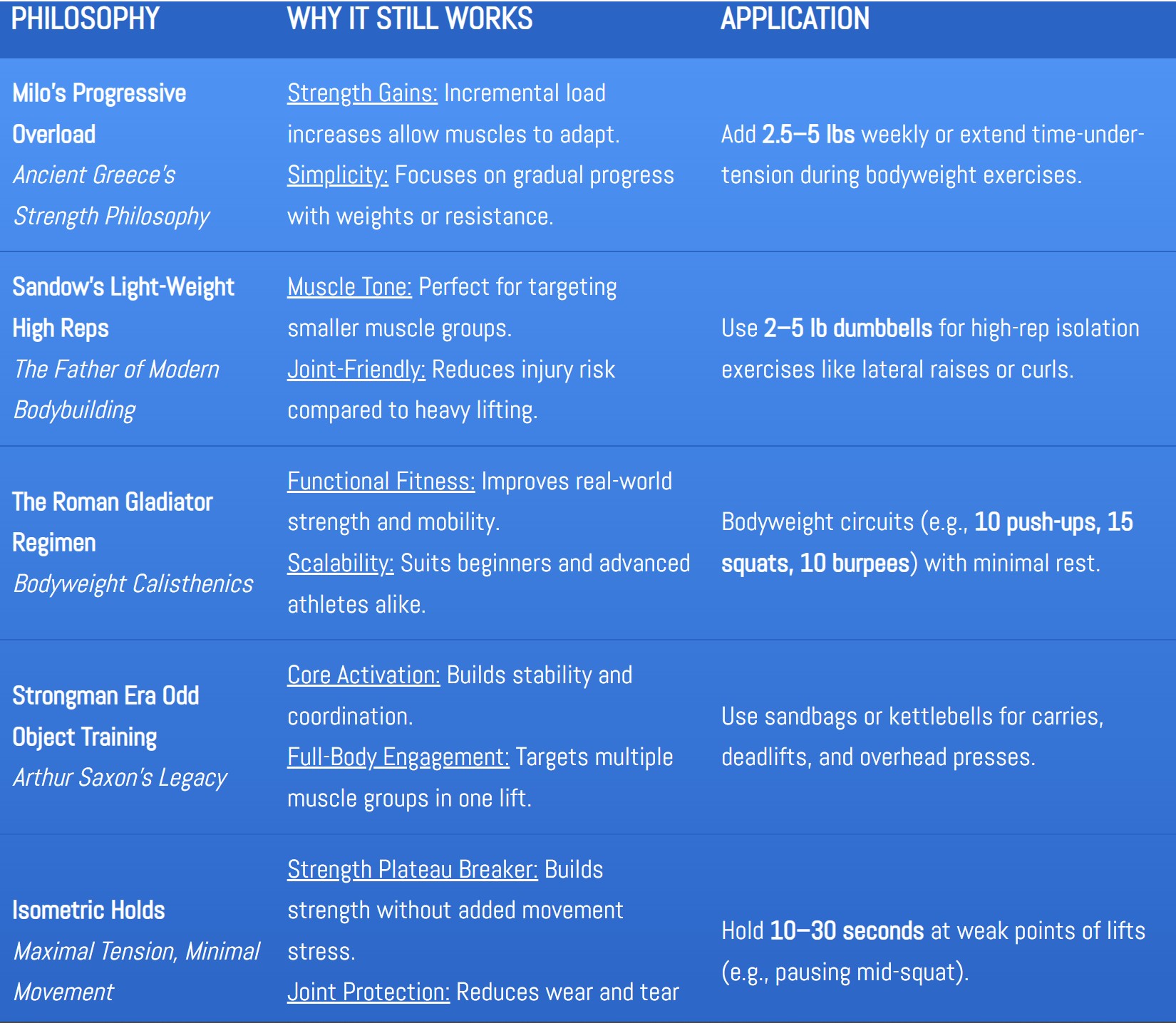Fitness trends come and go, but some forgotten training systems from the past hold timeless value. These legacy techniques—from ancient calisthenics to 20th-century strength-building methods—can still make a profound impact on your workouts today. Let’s uncover these forgotten gems and learn how to adapt them for modern fitness routines.
The Lost Art of Legacy Training
Legacy training techniques were built on simplicity, consistency, and mastery of basic movement patterns. Before the advent of machines and apps, athletes relied on natural resistance, bodyweight movements, and functional exercises to build strength, endurance, and resilience. While they may no longer dominate gyms, these philosophies can fill critical gaps in today’s routines.
Comparison Chart of Timeless Strength Philosophies
1. Milo’s Progressive Overload: Ancient Greece’s Strength Philosophy
Milo of Croton, an ancient Greek wrestler, pioneered progressive overload. Legend says he carried a growing calf daily until it became a full-grown bull—gradually increasing the weight his body had to handle.
Why It Still Works:
- Strength Gains: Incremental load increases allow your muscles to adapt.
- Simplicity: Focuses on gradual progress with weights or resistance.
- Application: Add 2.5–5 lbs to lifts each week, or extend time-under-tension during bodyweight exercises like planks.
2. Sandow’s “Light-Weight High Reps” Method
Eugen Sandow, the father of modern bodybuilding, emphasized light weights and precise movements to sculpt a well-balanced physique. His goal? Symmetry and definition, not just bulk.
Why It Still Works:
- Muscle Tone: Perfect for targeting smaller muscle groups.
- Joint-Friendly: Reduces injury risk compared to heavy lifting.
- Application: Incorporate 2–5 lb dumbbells for high-rep isolation exercises, like lateral raises or bicep curls.
3. The Roman Gladiator Bodyweight Regimen
Gladiators relied on bodyweight calisthenics to build endurance and explosive power. Exercises like push-ups, squats, and burpees were their staples, combined with functional movements like carrying weights or swinging clubs.
Why It Still Works:
- Functional Fitness: Improves real-world strength and mobility.
- Scalability: Suits beginners and advanced athletes alike.
- Application: Use bodyweight circuits with minimal rest (e.g., 10 push-ups, 15 squats, 10 burpees) for metabolic conditioning.
4. The “Strongman Era” Odd Object Training
Early 20th-century strongmen, like Arthur Saxon, lifted awkward, uneven objects—barrels, stones, and sandbags—to build functional strength. These irregular shapes forced their bodies to engage stabilizing muscles.
Why It Still Works:
- Core Activation: Builds stability and coordination.
- Full-Body Engagement: Targets multiple muscle groups in one lift.
- Application: Use sandbags or kettlebells for exercises like carries, deadlifts, and overhead presses.
5. Isometric Holds: Maximal Tension, Minimal Movement
Isometric exercises, popularized in the mid-1900s, involve holding a position under tension without moving. Think of planks, wall sits, or static pull-up holds.
Why It Still Works:
- Strength Plateau Breaker: Builds strength without added movement stress.
- Joint Protection: Reduces wear and tear compared to dynamic exercises.
- Application: Add 10–30 second holds at the weakest points of your lifts (e.g., pausing mid-squat).
Legacy Training vs. Modern Fitness: A Comparison
| Feature | Legacy Techniques | Modern Fitness |
|---|---|---|
| Focus | Function, simplicity, and consistency | Specialization and convenience |
| Equipment | Bodyweight, free weights, odd objects | Machines, apps, and wearables |
| Philosophy | Mastery of movements | Trend-driven programs |
| Best For | Strength, endurance, and mobility | Specific goals (e.g., hypertrophy) |
| Time Commitment | Full-body, time-intensive routines | Short, high-intensity sessions |
How to Adapt Legacy Techniques to Modern Fitness
Integrating legacy training into your routine doesn’t require a full overhaul. Here’s how to blend the best of the past and present:
1. Start with Functional Movements
- Incorporate bodyweight circuits or odd-object lifts for variety and balance.
2. Use Progressive Overload
- Add weight or reps weekly, even in lightweight isolation exercises.
3. Try Isometric Finishers
- After your main workout, hold a plank or a loaded position (e.g., mid-bicep curl) for 30 seconds.
4. Mix Light and Heavy Days
- Alternate between high-rep light-weight days and low-rep heavy lifts for a well-rounded program.
Sample Legacy-Inspired Routine
| Day | Workout Focus | Examples |
|---|---|---|
| Monday | Bodyweight Calisthenics | Push-ups, squats, burpees, plank holds |
| Wednesday | Odd-Object Lifting | Sandbag carries, kettlebell swings |
| Friday | Isometric Training | Wall sits, static lunges, pull-up holds |
| Saturday | Progressive Overload Weights | Deadlifts, bench press, pull-ups |
Why Legacy Techniques Matter
Modern fitness often prioritizes convenience and trends, but legacy training teaches discipline, patience, and balance. These systems:
- Build functional strength.
- Enhance mobility and endurance.
- Create a connection to movement and self-mastery.
As fitness evolves, blending old-school methods with new strategies can help you achieve results while honoring the wisdom of the past.
FAQs About Legacy Training Techniques
Q: Are legacy techniques still effective for muscle building?
A: Yes! Methods like progressive overload and odd-object lifting can build strength and mass just as effectively as modern programs.
Q: Do I need special equipment for legacy training?
A: Not necessarily. Bodyweight exercises and common objects (e.g., sandbags, stones) are perfect for starting.
Q: Can beginners use these techniques?
A: Absolutely. Start with low-intensity calisthenics or light weights, then progress as your strength improves.
The Bottom Line
Legacy training techniques are more than just fitness history—they’re tools for building a stronger, more functional body. Whether you’re tired of modern gym routines or seeking to improve functional fitness, these methods have stood the test of time. Incorporate these timeless principles, and you’ll not only revamp your workouts—you’ll rediscover the art of training with purpose and intention.
Ready to bring the old school back into your routine? Start today!

